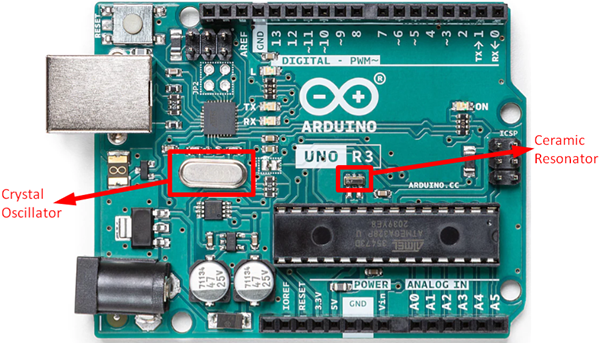Arduino Ceramic Resonator
Ceramic resonators consist of piezoelectric ceramic material having two or more metal electrodes attached. When connected in an electrical circuit they generate a constant clock signal with specific frequency just like a crystal oscillator. Generally ceramic resonators are used where cost is low and high performance is not mandatory.
Arduino is a complete development board containing multiple peripherals that are needed to run Arduino boards. Among all Arduino components oscillators are the one which plays a major role in working of Arduino.
Arduino have two types of microcontrollers one is the main controller Atmega328 which controls Arduino logic while the second one which is responsible for Arduino serial interface is Atmega16u2. Both these microcontrollers have an internal clock of 8MHz but both also contain an external clock of 16MHz. To make this clear here is a division of clock sources for each of the microcontrollers.
| Microcontroller | Clock Source |
|---|---|
| Atmega328p | Ceramic Resonator |
| Atmega16u2 | Crystal Oscillator |
Main purpose of ceramic resonators in Arduino is to generate clock signals for ATmega328P microcontrollers; ceramic resonators feature less precision than crystal oscillators. This ceramic resonator has a clock frequency of 16MHz.
In general practice, a ceramic resonator is sufficient for an Arduino microcontroller; however, this oscillator circuit is not good for time keeping or where timing precision is required. To do that we need an external RTC module for more accuracy in time-based applications.
Difference between Crystal and Ceramic Resonator
Normally ceramic and crystal oscillator both serve the same purpose of generating a clock signal in Arduino however, there are some construction differences between them which we will highlight below:
Frequency Range: Crystal oscillators have higher frequency range than ceramic resonators, this is because of the high Q factor of crystal oscillators. Crystal oscillator frequency ranges from 10kHz-100MHz while that of ceramic resonators varies from 190kHz-50MHz.
Manufacturing Material: Both crystal and ceramic oscillator is made up of piezoelectric resonator material. Crystal oscillator is made using Quartz while ceramic resonator is made of Lead zirconium Titanate. Ceramic resonators are easy to manufacture as compared to crystal oscillators.
Tolerance & Sensitivity: Ceramic resonator has high tolerance against shock and vibration as compared to crystal oscillator. Oscillators are more sensitive to radiation. Quartz has frequency tolerance of 0.001% while Lead zirconium Titanate used in ceramic resonators has 0.5% frequency tolerance.
Effect of Temperature: Output resonant frequency in ceramic resonators is determined by the thickness of material used while oscillator output is defined by the size, shape, and speed of sound in that material. Crystal oscillators are more stable in terms of temperature variations however ceramic resonators have more dependency on temperature; slight change in temperature can affect their output resonant frequency.
Capacitor Dependency: Both ceramic and crystal oscillators need a capacitor. Resonator may have internal capacitor while oscillator needs external capacitor to work.
Output: Crystal oscillator provides more stable resonant frequency in output as compared to resonator. This is because ceramic materials are sensitive to temperature changes which can affect output frequency. Crystal oscillators have accuracy greater than ceramic resonators.
Applications: Crystal oscillators are used here high-speed serial communication is required like in Arduino Atmega16u2 uses crystal oscillator for serial interface. Ceramic resonators can be used where frequency stability is not much important, like in microprocessors or microcontrollers. TVs, video games, and even children’s toys that have electrical components use crystal oscillators.
In case of timekeeping, crystal oscillators are more accurate if properly tuned with external variable capacitors, then only have an error of a few minutes per year.
Conclusion
Arduino has two microcontrollers that both rely upon external clock sources in the form of crystal oscillator and ceramic resonator. Ceramic resonator in Arduino is used by the Atmega328p chip. Using this resonator Arduino maintains its resonant frequency to process different logics. Further both oscillators are different in terms of working and construction however both serve the same purpose of generating 16MHz clock for Arduino microcontrollers.

